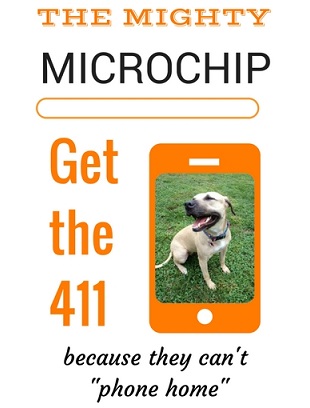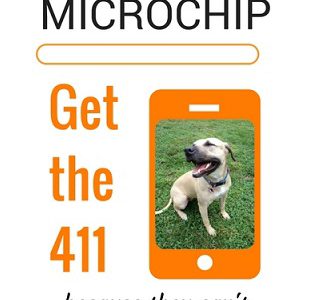
The Role of Microchips
MICROCHIP MUSTS:
- Get your dog or cat microchipped.
- if you adopted and your pet is already chipped, add YOUR info to the reigstration.
- If you move or change your contact info, be sure to update your microchip registration info.
- Have your vet scan your pet annually to be sure their chip can still be found.
All chips are NOT created equal!
It is NOT a GPS tracking device, and they are only as good as the info registered and the thoroughness of a pet being scanned.
A microchip is about the size of a grain of rice. It is injected into your pet’s shoulder area, but does not create any real pain. When scanned, it connects with REGISTERED info that identifies the owner of the pet.
The AAHA Universal Pet Microchip Lookup tool was created to assist those scanning pets to track a detected microchip down in order to locate the person registered to the microchip.
But not ALL microchips will be found using this tool!
Even if the shelter or rescue you adopt from has registered your pets chip (and some may not formally register them), you want YOUR info to be associated with your pet as well.
Lost Dogs of America (LDOA) has a wealth of experience and knowledge so visit their site to learn more including why you should use a google voice number when your pet goes missing.
And remember, if you see a stray pet that “Not All Strays Are Homeless”.
What You Likely Don’t Know (and topics on LDOA site include)
The Microchip Maze – Buyer Beware! Part 1 – The 900 Chips (note: here’s a corrected link for the 4th paragraph article reference). Learn more about 900 chips on our Microchips resource page.
The Microchip Maze – Part 2 – Searching the Databases
Lost Dogs of Illinois “dead end microchip” resource!
The experience of Marilyn Knapp Litt, Former Director of Lost Dogs of Texas, (who following Hurricane Katrina in 2005 formed a group of volunteers to successfully reunite animals displaced by the storm with their families) provided the information in a fabulous article “How To Trace Dead End Microchips and Tag Information on Found Pets”.
This free dead end chip assistance is now provided by Lost Dogs Illinois volunteers (Microchip Hunters).
Visit Microchiphelp.com for details. Check out their statistics helping to reunite pets through this volunteer effort.
August 15 is Check the Chip Day
Below is info provided on the AVMA website related to “Check the Chip Day”!
Microchips greatly increase the chances that pets will be reunited with their families if they are lost or stolen…but a microchip only works if its registration information is accurate.
This annual awareness day was created “to remind pet owners to have their pets microchipped and to keep the registration information up-to-date, AVMA and the American Animal Hospital Association (AAHA) joined together to create “Check the Chip Day.”
Pet owners:
Make YOUR Check the Chip Day the next time YOU visit your vet! Or schedule the implant of a microchip soon!
(then make sure that your pet’s chip is immediately registered).
Updating your pet’s microchip registration
To update your pet’s registration, you’ll need your pet’s microchip number. If you haven’t already created an account with the manufacturer, you’ll need to do that as well so you can access the registration in the future to update the information. Make sure that all of the information, particularly your phone number(s) and address, are correct.
There are many databases that allow you to register your pet’s microchip, but the one that really counts – the one that animal shelters and veterinarians will search – is the database maintained by the manufacturer of your pet’s microchip. AAHA’s Universal Pet Microchip Lookup Tool is linked to the registries of the majority of microchip manufacturers and allows a quick database search of any microchip made by these manufacturers. In addition, a number of public microchip registries have also been linked to the AAHA Universal Pet Microchip Lookup Tool to make it easier to find a microchip’s registration.
Manufacturers and databases that participate in the AAHA Universal Pet Microchip Lookup Tool is outlined on our Microchip Resources page.
Don’t forget a collar and visible tag!
While a microchip is essential, there is no quicker way to get a lost pet home than by looking at a tag with immediate owner contact info!
So add the collar and tag with a microchip for a DYNAMIC DUO.
Keeping your pet out of a shelter if picked up by a stray and not being able to be quickly reunited will only contribute to the shortage of kennel space. So KEEP YOUR PET SAFE and SAVE A SHELTER SPACE.





